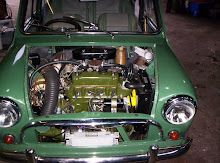Expert drivers were quick to appreciate the light, precise steering and the excellent roadholding of these little cars, qualities which were subsequently demonstrated in many international road rallies, races and similar competitive events. Unlike many modern
Fig. 6. The Clubman Estate continues the popular series of Mini estate cars
cars, they should maintain an equal standard of stability when driven fast in gusty side winds.
Any lack of precision in the steering, or tendency to wander, therefore, calls for investigation. Similarly, instability when cornering fast or when the car is driven over a pot-holed surface at speed (the all-independent suspension normally deals exceptionally well even with atrocious road surfaces) suggests that the shock absorbers have weakened and are due for replacement.
A word of caution is, perhaps, advisable in the case of the estate car and van. The urge to forge ahead at too high a speed on rough tracks should be curbed if a full load is being carried, owing to the risk of the underside of the car bottoming on bumpy surfaces. This does not imply, of course, that the ground clearance is inadequate. At about 6£ inches (with the car laden) it compares favourably with many much larger models. A further point is that the disposition of the load can affect the handling qualities. It should be arranged as far forward as possible, since a tail-heavy car will develop an over-steering characteristic—a term which simply means that the tail will tend to swing outwards if corners are taken fast.
Braking System. The powerful and progressive Lockheed hydraulic brakes contribute to the excellent average speeds that can be put up during the course of a fast cross-country run when the car is being really hurried. Ordinarily, of course, it is bad practice to "drive on the brakes." When in good condition the brakes should call for only light pedal pressure during normal braking and moderately firm pressure to obtain maximum retardation, when the car should pull up all-square. The latter characteristic should be retained when the brakes become really hot through frequent use, and the travel of the brake pedal should not increase appreciably; in other words, the brakes are not prone to "fade" and if this symptom is detected, it is probable that incorrect linings have been fitted to the shoes at some time, or that the braking system as a whole requires a complete overhaul, as described in Chapter 10.



0 comments:
Post a Comment